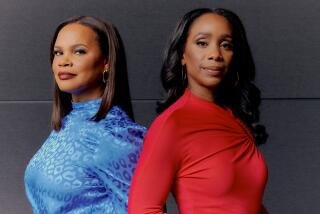New News Philosophy Paying Off for KNBC
Her world is television, the visual medium, and so important stuff first: A year ago, Colleen Williams, the veteran KNBC-TV Channel 4 news anchor known for the hereditary white streak in her hair, took her then 3-year-old son to see the Disney movie “101 Dalmatians.”
“He came out of the theater, stared up at me and said, ‘Mom, you look just like Cruella De Vil,’ ” Williams recounted. “And that was that. It was out with the white and in with the new.
“So I walked in the newsroom, feeling like I was exposing myself to the world, and most people didn’t even notice. But the moment I went on the air, I guess because it’s such a tight shot on my head, the phones rang off the wall for weeks. Literally hundreds of people called, asking why, saying yea or nay. Without a doubt I received an overwhelmingly greater response to that than to anything else I have ever done.”
But it’s not a great dye job that has propelled Williams and Channel 4 to the top of the local news heap. In last month’s sweeps, Channel 4 won every head-to-head news battle over all rivals in all time periods, from early morning to late at night. And the two shows Williams anchors alongside Paul Moyer at 5 and 11 p.m. finished as the two highest-rated daily newscasts in this market, even more popular than network broadcasts.
Those achievements, Williams said, were born instead from her station’s concerted efforts over the last three years to transform the daily newscasts from depressing, often scary lists of every murder, rape and bloody accident that occurred that day to a slightly rosier picture of the world that includes positive, do-gooder reports as well.
“That was the one complaint that I had from people I’d meet in the community--that we only covered the salacious, bad news,” Williams said. “We never covered education or the people who tried every day to do something good for their neighborhood. I still think that viewers need to know what’s happening, but they also need to know that everything out there is not bad and scary. I’m much prouder about what we do now. I don’t have to hang my head when my parents are watching, or my neighbors. I’m not taking the heat for all that blood and guts like I used to.”
Though the crime blotter and live police pursuits still consume a good portion of most local newscasts, this move to softer, lifestyle reporting has been an oft-trumpeted trend at many local stations in recent years. It is a trend, Channel 4’s top executive said, that her station instigated with weekly features that spotlight innovative teachers, community volunteers and common folk who overcome hardships and thrive.
“When I arrived here [in July 1994], I didn’t care for the kind of balance we had in news. I didn’t like the news in town, period,” said Carole Black, Channel 4’s general manager. “Most people were doing news that I would call sensationalized. It had a tabloid slant, and a lot of people I talked to said they had stopped watching local news altogether.
“What we have done over the past 3 1/2 years is tell more stories that are community-based. More news you can use, medical breakthroughs and stories on health, practical information. What people would call softer news. We have to report the news, and there are murders and there is crime. But that was all that was being reported. So we benefited from that shift, and I think just about everyone in town has followed suit.”
Channel 4 has also benefited from “The Rosie O’Donnell Show.” Before her daytime talkfest premiered in the summer of 1996, “The Oprah Winfrey Show,” airing at 3 p.m. on KABC-TV Channel 7, crushed all competition and provided a tremendous advantage as a lead-in for Channel 7’s long-dominant afternoon news block. But “Rosie” arrived, basically doubling Channel 4’s rating in that hour preceding the news.
“Anchors would love to think it’s only them when things go right, but it’s not,” said Moyer, who left top-rated Channel 7 for big money at Channel 4 in 1992. “We started to win here much sooner on the 11, but in the afternoon, ‘Oprah’ was so dominant that we were really starting 10 feet underground. ‘Rosie’ really gave us a boost overnight.”
“I think eventually we would have overtaken them anyway, but ‘Rosie’ allowed us to do that a year or more sooner,” Black said. “There is no question that we got more viewership and we are able to promote our newscasts during her show. But ‘Rosie’ usually trails ‘Oprah,’ and our news still comes out on top.”
Buoyed in part by NBC’s lead in prime time, Channel 4 has been coming out on top at 11 p.m., the most advertising rich news time period, for three years. But last October, the station voluntarily broke up its winning 11 p.m. team of Moyer and Kelly Lange, placing Williams, who’d already teamed with Moyer at 5 p.m. for nearly five years, alongside him at night as well. (Lange still anchors the station’s 4 p.m. newscast and is developing a new program for a national audience on cable.)
Black said the change posed little risk because her market research assured that the station could win at 11 p.m. with either Williams or Lange alongside Moyer and weather and sports fixtures Fritz Coleman and Fred Roggin. And settling on one “lead team” at 5 and 11, Black added, enables the station to promote its news personalities with greater efficiency.
“I worked hard for years to get to this point, to get this promotion, and it was always my dream that it would happen,” Williams said. “But there is extra pressure when you step into a newscast where ratings have been good, where they have been winning without you. I’m happy we won with me too.”
Williams began her career in Omaha, Neb., after studying education at Creighton University and the University of Nebraska. She did the farm report on radio for a year, then was hired in 1978 by the ABC television affiliate there because, she said, the station’s executives liked the sound of her voice. She then stopped off in San Francisco and at KCBS-TV Channel 2 here before landing at Channel 4 in 1986 as a weekend anchor.
“I never really thought about being an anchor,” Williams said. “I was a reporter in Omaha and I loved that, but one day I walked into the station and the anchor man’s contact lens had rolled up in his eye. I was the only one there, so they said, ‘You’re on.’ And talk about cosmetics. I don’t even think I combed my hair I was so nervous. Someone put the scripts in front of me and said, ‘Read.’ I had never been in the studio before. I wasn’t even sure what a TelePrompTer was until I saw it.”
“You learn the most about someone during breaking news, when things are unscripted, and Colleen is always cool and substantial,” Moyer said. “She is so aware of what’s going on. She takes copious notes. She learns fast. She’s a good listener, and she knows the right questions to ask. And I think the audience senses that and really trusts her and the information she conveys.”
Williams believes that it’s their compatibility in live situations that has made her and Moyer L.A.’s most popular anchor team. And she claims that it’s that credibility under fire--earned during such huge stories as the Northridge earthquake, the O.J. Simpson trial and the bombing at the Atlanta Olympics--that has brought viewers to the station’s everyday newscasts.
“We both have longevity here and are familiar to the audience,” said Williams, who was forced to evacuate the KNBC studio in the Atlanta park where the bomb exploded and then report live over a cellular phone as she and Moyer literally ran to a backup TV set more than a mile away.
“We have worked all these stories together, and we see things differently. He has been here in this city for decades, he grew up here, and he’s great at adding perspective and history to what’s going on. Whereas I see the picture and try to point out what’s happening right there at that very minute. I tend to do the play-by-play and he’s sort of the color guy. And that chemistry just really works. It’s like a marriage where our skills blend rather perfectly.”
More to Read
The biggest entertainment stories
Get our big stories about Hollywood, film, television, music, arts, culture and more right in your inbox as soon as they publish.
You may occasionally receive promotional content from the Los Angeles Times.










